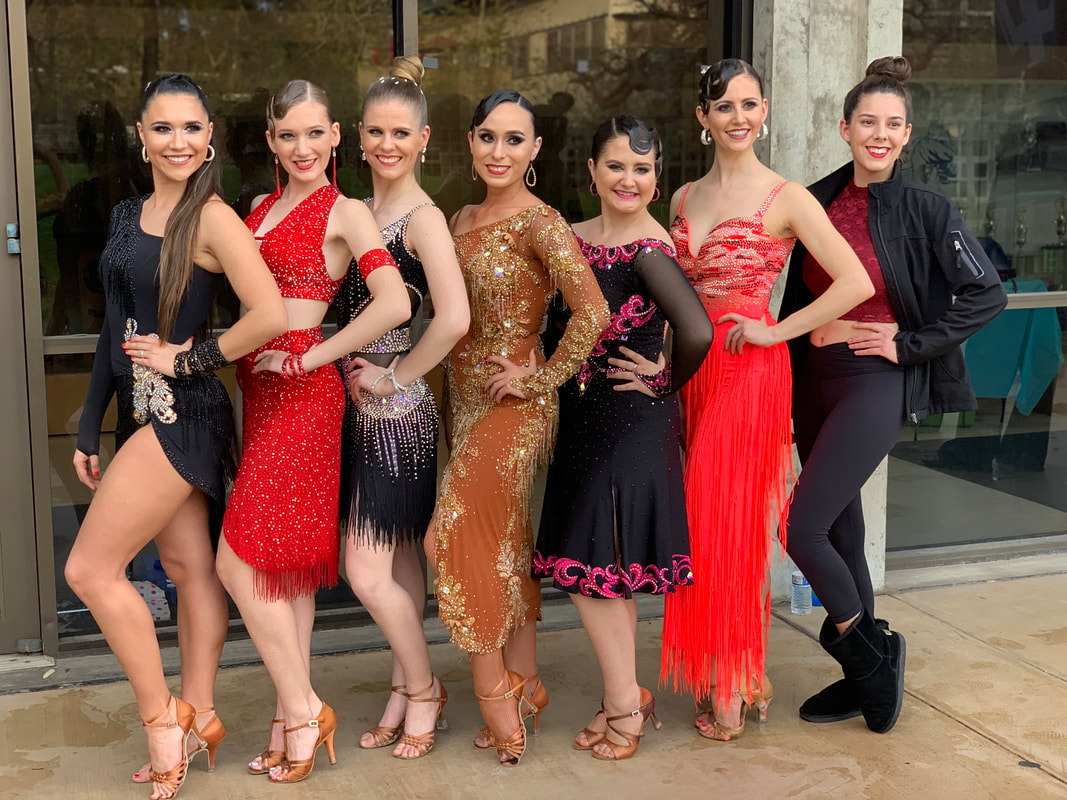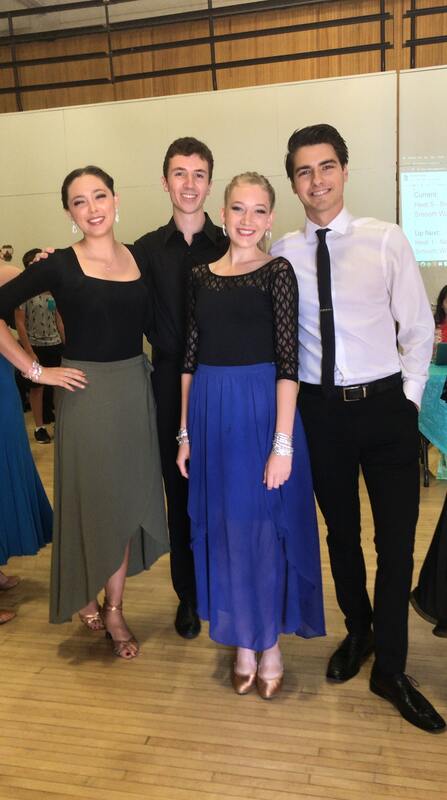Everything you could possibly need to know about costumes before competing.
Choosing a Dancesport Costume
Are you saying I need to buy a costume? What does “costume” entail?
No, you do NOT need to buy a costume to compete. In fact, most collegiate competitions do NOT allow “costumes” until at least the silver syllabus level across all categories (Standard, Smooth, Latin, Rhythm). The costumes that are not allowed at the newcomer through silver levels at collegiate competitions are costumes designed specifically for dancing, such as tail suits and custom gowns/dresses.
What IS allowed then?
Dancesport practice wear and cocktail attire are both allowed, and are worn by both men and women in the newcomer to gold levels. Practice wear is designed for the figures and movements of ballroom, and is typically more expensive than cocktail attire, so this article will give special attention to the latter rather than the former. Note: it is also common to use dresses or skirt/shirt combos already on hand for follows.
Though there are major differences between Standard & Smooth and Rhythm & Latin, the costuming is (thankfully!) rather similar.
No, you do NOT need to buy a costume to compete. In fact, most collegiate competitions do NOT allow “costumes” until at least the silver syllabus level across all categories (Standard, Smooth, Latin, Rhythm). The costumes that are not allowed at the newcomer through silver levels at collegiate competitions are costumes designed specifically for dancing, such as tail suits and custom gowns/dresses.
What IS allowed then?
Dancesport practice wear and cocktail attire are both allowed, and are worn by both men and women in the newcomer to gold levels. Practice wear is designed for the figures and movements of ballroom, and is typically more expensive than cocktail attire, so this article will give special attention to the latter rather than the former. Note: it is also common to use dresses or skirt/shirt combos already on hand for follows.
Though there are major differences between Standard & Smooth and Rhythm & Latin, the costuming is (thankfully!) rather similar.
|
For LEADS:
Standard & Smooth: Tailored dress slacks & dress shirt (which also serves as a good basic framework for most costuming for leads). A necktie or bow-tie is not absolutely necessary but gives a polished look. Latin & Rhythm: Similar to above, but no vest or tie. A fitted athletic shirt (such as Under Armour) may be worn instead of the dress shirt or underneath. A few top buttons can be undone. Nightclub: Salsa, Merengue: Same as Latin & Rhythm Argentine: Same as Standard & Smooth; vests are especially common. Lindy: Same as Standard & Smooth but without a tie & vest; suspenders are common but optional. |
For FOLLOWS:
Standard & Smooth: Dresses or skirts with a blouse may be worn. In length, the skirts should be at least past the knees but definitely above the ankles. Latin & Rhythm: Again, dresses or skirts with a blouse may be worn. Length is not as crucial as with a Standard/Smooth costume, but should ideally emphasize the line created from your pointed toe upwards. Knee lengths to mid-thigh lengths are common. Nightclub: Salsa, Merengue: Same as Latin & Rhythm. Argentine Tango: Dress/skirt with a cut to allow for proper steps and flicks. Lindy: Pants or skirt with a shirt that allows for kicks and swingouts. |
*** Costumes in the Nightclub category vary from dance to dance and are not as strict as Ballroom/Latin syllabus levels, but there are common styles. Be aware that nightclub events at competitions are most often back to back, so there is little or no time to change.
How to be sure your costume will work on the dance floor!
|
For LEADS:
Tailoring should be flattering but should never inhibit proper frame. Wear an undershirt under dress shirts. Vests are also optional in Ballroom and Latin outfits, but should also follow the guidelines above for fit and movement. Be sure shirt cuffs CAN be buttoned, and that the shirt is long enough to be tucked in. |
For FOLLOWS:
Be sure to have undergarments that will be proper for dancing! Figure out what underwear you will be wearing. Additionally, wear shorts under skirts/dresses and/or tights. Standard & Smooth Outfits: Skirts (or the skirt of the dress) should be full enough to take proper steps in. The top of the dress or the blouse that will accompany your skirt should fit so that you can take and maintain frame. Be sure that your blouse can be tucked in. For secure fit, I highly recommend halter and spaghetti strap styles, and very much discourage strapless styles. Tops that flow well look nice but be sure you don’t get caught on your partners’ clothes. How do you see if your dress/skirt will allow you to take proper steps? I do the Tango Test first. Take Tango frame, making sure there is a slight bend in your knees. Maintaining proper frame, point a toe and slowly (slowly!) begin to reach behind with your toe. IF you cannot reach more than a foot and half from the heel of your standing foot to your pointed toe without severely stretching the material or stepping on the bottom of the dress, then do NOT choose this costume. If you can, congrats! You have a Standard/Smooth costume. Latin & Rhythm: Skirts need not be as full as for Standard & Smooth, but it is important that they move well and do not ride up! For tops, follow the guidelines above. |
Aesthetics: What “look” is appropriate for each dance category.
Before reading this section, I want to emphasize to you that fit, movement and comfort should come first and foremost in your search for a costume; these things are very much part of a costume’s aesthetic. Though these costumes are not necessarily something you might wear to the grocery store or to class, it is important that you do not feel uncomfortable or self-conscious.
|
For LEADS:
All categories: Slacks in dark—navy blue or black are ideal. A good general color for dress shirts is black or white; other colors can be worn but be sure to find out what color your partner is wearing so the colors can match or complement each other. Vests and ties should also complement or match the colors your partner is wearing. Following through with good partner communication, show your costume to your partner so that he/she can confirm nothing will clash! |
For FOLLOWS:
All Categories: I highly recommend against wearing black because many leads wear dark slacks and a dark shirt or vest, so wearing black makes it difficult to stand out while on the floor. Make sure to show your costume to your dance partner so he can pick colors that won’t clash. Standard & Smooth: Flowey fabrics such as lightweight satin, charmeuse, chiffon, or any other lightweight fabrics work great. Color schemes vary from deep colors (navy blue, royal purple, emerald green) to bright colors (bright orange, hot pink). This is the fun & easy part! Pick a color that you like and accents your skin tone. Latin & Rhythm: Stretch fabrics such as lycra blends accentuate the line from the point of the toe upward. However acknowledging that these fabrics tend to be clingy, it is much more important that you feel comfortable! Styles that move well in these dances include fringe, asymmetric hems, and tiered ruffles. Color schemes tend to include colors such as white, cream and bright colors (red, pink, orange, yellow, bright greens/blues). Again, pick a color you like and which accents your skin tone! |
Finally, be sure to practice a few times in your costumes! Wear your full ensemble including the proper undergarments to make sure you won’t have any costume malfunctions on competition day! Always feel free to dress up for a Sunday practice.
If you do have any questions or concerns—general or specific–you can always ask any of our officers! Happy dancing!
If you do have any questions or concerns—general or specific–you can always ask any of our officers! Happy dancing!
Originally posted January 17, 2012 on
http://cotillionatucsb.com/choosing-a-dancesport-costume/
http://cotillionatucsb.com/choosing-a-dancesport-costume/


